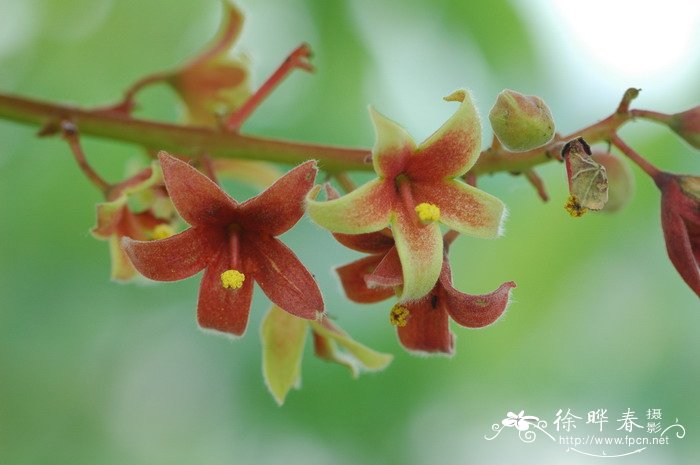掌叶苹婆Sterculia foetida
中文名(Chinese Name):掌叶苹婆
学名(Scientific Name):Sterculia foetida L.
英文名(English Common Name):hazel sterculia
别名(Chinese Common Name):复叶苹婆
异名(Synonym):Clompanus foetida (L.) Kuntze Clompanus foetidus (L.) Kuntze Sterculia mexicana var. guianensis Sagot
科属(Family & Genus):梧桐科(Sterculiaceae)苹婆属
形态特征(Description):乔木;枝轮生,平伸。叶聚生于小枝顶端,为掌状复叶,有小叶7-9片,小叶椭圆状披针形,长10-15厘米,宽3-5厘米,顶端长渐尖或尾状渐尖,基部楔形,幼时有毛,成长后无毛;叶柄长10-20厘米;托叶剑状,早落。圆锥花序直立,着生在新枝的近顶部,有多花;小苞片细小,花梗比花短;萼红紫色,长约12毫米,5深裂几至基部,萼片椭圆状披针形,向外广展,外面被淡黄褐色短柔毛,内面的上部密被白色长绒毛,远比萼筒长;雄花的花药12-15个,聚生成头状;雌花的心皮5枚,被毛,花柱弯曲,柱头5裂。蓇葖果木质,椭圆形且似船状,长5-8厘米,顶端急尖如喙状,几无毛,每果有种子10-15个;种子椭圆形,黑色而光滑,长约1.5厘米。花期4-5月。
分布(Distribution):产热带的亚洲、东非及澳洲北部,现台湾,广东等地有栽培。
用途(Use):本种的种子炒熟后可食,味如栗子;但花有臭味。
引自中国植物志英文版:FOC Vol. 12 Page 304, 305
Sterculia foetida Linnaeus, Sp. Pl. 2: 1008. 1753.
香苹婆 xiang ping po| Sterculiaceae | Sterculia
Trees. Branches verticillate and spreading. Leaves apically clustered, palmately 7-9-foliolate; stipules arrow-shaped, caducous; petiole 10-20 cm; leaflet blades elliptic-lanceolate, 10-15 × 3-5 cm, at first pilose, glabrescent when mature, base cuneate, margin entire, apex long acuminate or caudate. Inflorescence apical on branchlets, paniculate, erect, many-flowered. Pedicels shorter than flowers. Epicalyx lobes minute. Calyx purple-red, ca. 12 mm, divided nearly to base, lobes elliptic-lanceolate, abaxially yellowish brown pubescent, adaxially upper half white villous. Male flowers: stamens 12-15, capitate. Female flowers: carpels 5, hairy. Style curved; stigma 5-divided. Follicle ellipsoid and boat-shaped, 5-8 cm, woody, nearly glabrous, apex acute into beak, 10-15-seeded. Seeds black, ellipsoid, ca. 1.5 cm, smooth. Fl. Apr-May.
Cultivated. Guangdong (Guangzhou), Guangxi, S Hainan (Sanya) [Cambodia, India, Indonesia, ?Malaysia, Myanmar, Philippines, Sri Lanka, Thailand, Vietnam; native to India, now cultivated in tropical Africa, N Australia, and South America].
Sterculia foetida seems to be a rather weedy species of uncertain origin. The seeds are edible after toasting and taste like chestnuts (Castanea sativa Miller); they also contain an oil that is used medicinally, while the timber is used for making furniture and the bark for rope.


(责任编辑:徐晔春)
学名(Scientific Name):Sterculia foetida L.
英文名(English Common Name):hazel sterculia
别名(Chinese Common Name):复叶苹婆
异名(Synonym):Clompanus foetida (L.) Kuntze Clompanus foetidus (L.) Kuntze Sterculia mexicana var. guianensis Sagot
科属(Family & Genus):梧桐科(Sterculiaceae)苹婆属
形态特征(Description):乔木;枝轮生,平伸。叶聚生于小枝顶端,为掌状复叶,有小叶7-9片,小叶椭圆状披针形,长10-15厘米,宽3-5厘米,顶端长渐尖或尾状渐尖,基部楔形,幼时有毛,成长后无毛;叶柄长10-20厘米;托叶剑状,早落。圆锥花序直立,着生在新枝的近顶部,有多花;小苞片细小,花梗比花短;萼红紫色,长约12毫米,5深裂几至基部,萼片椭圆状披针形,向外广展,外面被淡黄褐色短柔毛,内面的上部密被白色长绒毛,远比萼筒长;雄花的花药12-15个,聚生成头状;雌花的心皮5枚,被毛,花柱弯曲,柱头5裂。蓇葖果木质,椭圆形且似船状,长5-8厘米,顶端急尖如喙状,几无毛,每果有种子10-15个;种子椭圆形,黑色而光滑,长约1.5厘米。花期4-5月。
分布(Distribution):产热带的亚洲、东非及澳洲北部,现台湾,广东等地有栽培。
用途(Use):本种的种子炒熟后可食,味如栗子;但花有臭味。
引自中国植物志英文版:FOC Vol. 12 Page 304, 305
Sterculia foetida Linnaeus, Sp. Pl. 2: 1008. 1753.
香苹婆 xiang ping po| Sterculiaceae | Sterculia
Trees. Branches verticillate and spreading. Leaves apically clustered, palmately 7-9-foliolate; stipules arrow-shaped, caducous; petiole 10-20 cm; leaflet blades elliptic-lanceolate, 10-15 × 3-5 cm, at first pilose, glabrescent when mature, base cuneate, margin entire, apex long acuminate or caudate. Inflorescence apical on branchlets, paniculate, erect, many-flowered. Pedicels shorter than flowers. Epicalyx lobes minute. Calyx purple-red, ca. 12 mm, divided nearly to base, lobes elliptic-lanceolate, abaxially yellowish brown pubescent, adaxially upper half white villous. Male flowers: stamens 12-15, capitate. Female flowers: carpels 5, hairy. Style curved; stigma 5-divided. Follicle ellipsoid and boat-shaped, 5-8 cm, woody, nearly glabrous, apex acute into beak, 10-15-seeded. Seeds black, ellipsoid, ca. 1.5 cm, smooth. Fl. Apr-May.
Cultivated. Guangdong (Guangzhou), Guangxi, S Hainan (Sanya) [Cambodia, India, Indonesia, ?Malaysia, Myanmar, Philippines, Sri Lanka, Thailand, Vietnam; native to India, now cultivated in tropical Africa, N Australia, and South America].
Sterculia foetida seems to be a rather weedy species of uncertain origin. The seeds are edible after toasting and taste like chestnuts (Castanea sativa Miller); they also contain an oil that is used medicinally, while the timber is used for making furniture and the bark for rope.
(责任编辑:徐晔春)
踩一下[1]

顶一下[3]